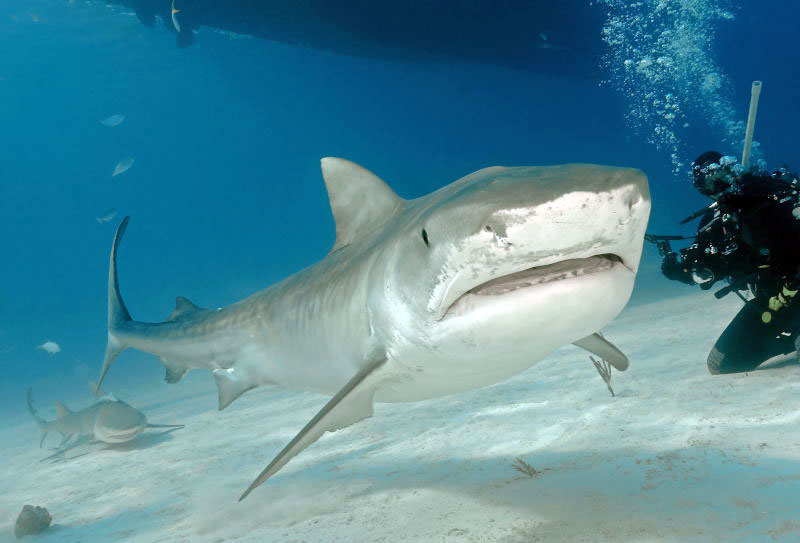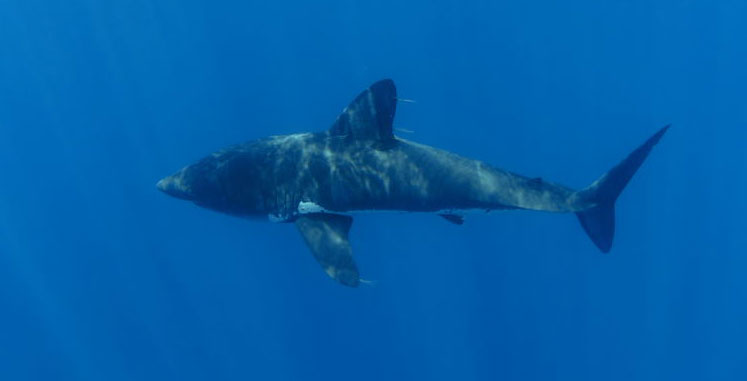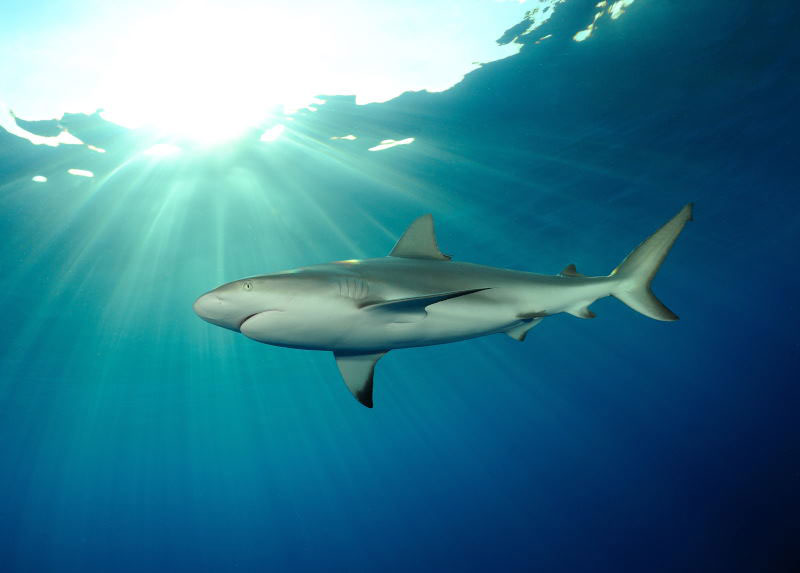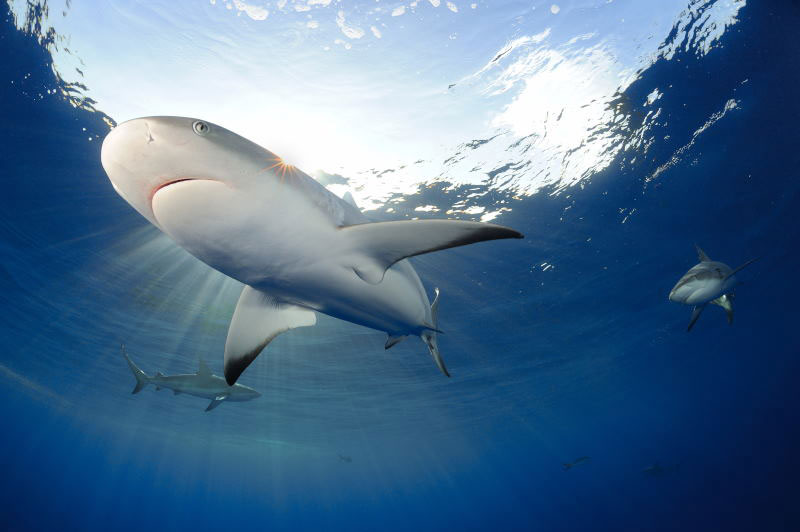“Always be looking down current!”
OK, Jim, I get it. This must have been the forth time he’s mentioned which way to be looking during our dive briefing. By the time he stopped talking he said it two more times. We were over the Little Bahama Bank and I needed to get wet. By now more than a few large animals circled under the boat. No giant strides here; you do a quiet head first seated entry and proceed to the sand below. It didn’t take long before we were in position with some ten good sized lemon sharks doing their version of pacing around us. I, of course, immediately got distracted and focused in on a pair of photogenic lemons. I felt completely calm enjoying the warm water when suddenly I was being shaken like a tambourine. At the same time I heard through a cascade of bubbles JJOOOOEEE…BLUB BLUB….WAH WAH…LOOOOK and there six inches from my face Jim Abernethy gave me the riot act, at the same time twisting me around to see a gigantic head less than two feet away eye to eye with me. It was Emma, the “playful” 14 foot female tiger shark who delights sneaking up on the clueless newbie. I hadn’t even been in the water ten minutes and had already forgotten – you guessed it – “Always be looking down current!”
Story by Joseph C Dovala, photos by Dovala Images
Things have changed a lot since Jaws and Blue Water, White Death, at least for those in the know. Far from being mindless eating machines, sharks are top end predators that have intelligence and even individual personalities. While shark mistakes, called shark “attacks” in the media, do still occur and draw enormous attention, people are beginning to understand the extremely important role that the shark plays in the ocean. They range in size from the dwarflatern shark of around 7 inches to the giant whale shark of some 40 feet in length. They occupy cold water, warm water, deep water, shallow water, and even fresh water. In short, you can find a representative of the shark family just about anywhere.
Sharks have been here since well before the dinosaurs and account for over 400 species throughout the world’s seas. They belong to the subclass Elasmobranchii which includes rays and skates. Members of this group are without swim bladders, have 5-7 gill slits, and small scales, among other less obvious characteristics. They have no bones per say and rely on cartilage and connective tissue to provide body structure. Their teeth are attached to the gums rather than the jaw and are replaced constantly. Some may go through 35,000 in their life time. Like other animals, the teeth have varied shapes depending on the type of food they eat. Some have more flattened teeth for crushing mollusks while others have serrated teeth for sawing through bone and blubber.
Shark skin is quite remarkable and quite different from the boney fishes. They have a network of collagenous fibers arranged in a three dimensional curve or helices called a placoid scale. They have a central blood fed pulp structure along with an outer layer of dentine (not the gum). If this sounds familiar, it is. It’s the basic form of a vertebrate tooth. The placoid scale then sits on top of the dermis, or skin. These scales cannot grow but more are simply added as the animal gets bigger. This structure creates tiny vortices that allow the animal to swim with less resistance and sound. An important trait if you’re trying to sneak up on prey. Due to the alignment of these denticles on the skin, when you rub a shark from tail to head it feels as rough as sandpaper (not a good idea), while rubbing in the opposite direction feels relatively smooth (still may not be a good idea). Shark skin is thick with the whale shark having as much as four inches covering its body.
Since sharks do not have swim bladders for buoyancy control they rely on large livers filled with oil. Together with the minimal weight of cartilage instead of bone, many species of sharks need only a small forward momentum to flush enough water across their gills. Nurse sharks are able to pump water over their gills which is quite easy to see if you spot one lying on the bottom. Sand tiger sharks are able to store air in their stomachs so they can remain motionless for longer periods. However, most sharks must keep swimming, no matter how slight, to get enough oxygen.
Most of the shark families are poikilothermic also erroneously called “cold-blooded.” That is they maintain a body temperature of the ambient water around them. The Lamnidae family however is homeothermic where they have elevated body temperatures, as much as 10 degrees higher. This allows for potentially more bursts of energy under certain circumstances. These animals have a strip of muscle that creates heat energy and is distributed through a counter current exchange mechanism.
Unlike most boney fish sharks bear small numbers of well developed progeny. They utilize three means to accomplish reproduction after internal fertilization. The first is called ovoviviparous in which the fertilized eggs hatch within the oviduct of the female. These embryos are fed by egg yolk and specialized glands within the oviduct. The baby sharks are then born fully functional. Some species practice oophagy where the first hatched consume their siblings as part of their nourishment. The second strategy, for mostly smaller benthic sharks, is called oviparity. The eggs are simply laid in the water and are protected by an egg case where they develop. Horn and swell sharks are two examples that use this method. The third, and most like mammals, is called viviparity. In this case the mother shark maintains a placental connection to her young and they’re born live and fully functional. Hammerheads and the requiem sharks such as bulls and tigers go this route. A surprising fact is that most shark species take a considerable time to reach sexual maturity. The lemon shark isn’t ready to reproduce until 12-15 years of age, same with the great white. In addition, many species do not mate every year like the tiger shark. It’s easy to see how excessive overfishing could decimate a population with such low reproductive rates (see sidebar).
Without a doubt, it’s the shark senses that mystify and have contributed to tall tales all over the world. In actuality their abilities to monitor their environment are quite astounding. We’ve all seen the movie or cartoon that shows the evil villain place a single drop of blood into a tank full of sharks and the water violently boils up. This naturally gives the impression that a shark brain is dedicated to nothing more than smelling and is connected to a mindless eating machine. Research into shark’s sense of smell has shown otherwise. Typically their nostrils are under the snout and unlike us have nothing to do with breathing. They are connected to what’s called ventral olfactory organs. This structure has but one job and that’s to “sniff” out stuff. For years it was thought that a huge portion of the brain was tied into this and was the only cue for the shark to behave. It turns out that the cascade of events a shark mulls over before pursuing prey is far more complex. Nevertheless, some species of sharks are able to detect certain amino acids at a concentration of one part per billion of sea water. And they can do this hundreds of meters away!
Along with smell, hearing is probably one of the shark’s first senses used to find a meal. A small outside opening on either side of the head connects to a three-chambered inner ear with an ear stone called an otolith. They’re particularly attracted to low frequency pulsating sound waves between 25 and 100 Hz. Although it appears they are able to hear a much wider frequency than this. Hearing is acute and when working in tandem with the lateral line mentioned below becomes a powerful prey recognition system.
The shark’s next detection apparatus is what’s called a lateral line. Many aquatic organisms have this sense organ. It’s made up of a series of fluid filled canals with cells called neuromasts. The cells are composed of a grouping of tiny hairs much like hearing organs. These cells detect motion and pressure changes in the water. Much of the shark’s lateral line is also made up of electroreceptors for detecting and monitoring changes in electromagnetic fields. Besides sensing prey the monitoring of magnetic fields may also be used in helping the animal to navigate.
A shark’s eye has the same basic design as a vertebrate eye. Their pupils are able to dilate and contract. There are a high proportion of rods which make them very sensitive to light especially between contrasts of brightness and shadow. In addition, they have a series of reflective plates called a tapetum lucidum. This structure reflects light back through the retina a second time basically acting as a light enhancer. Cats have these as well, however the sharks’ are considerably more effective. Some species, like the tiger shark, have what’s called a nictitating membrane that protects the eye from injury during close in hunting or attack. Others roll their eyeball back to avoid injury such as the great white. Contrary to yet another tall tale sharks have excellent eyesight and use it when it suits them.
Another specialized tracking organ is called the Ampullae of Lorenzini (AL). These are also specialized electrorecepters located primarily under the snout. They are jelly filled canals capable of sensing an incredibly small voltage differentiation. This organ may be a primary tool by which some sharks can find prey buried under sand such as rays and mollusks. It also appears the AL can measure water temperature. Sensory cells along with a glycoprotein may serve as a kind of transducer which converts temperature variations into electrical energy which the shark can detect.
Sharks also have taste buds and many researchers think that this is the final test on whether or not a shark decides that something is worth eating. One of the taste parameters might be relative fat content. That is, if the test bite doesn’t meet a certain threshold of required blubber percentage then a continued attack may not be worth the effort. Very little research has been conducted on shark tasting capabilities. However, this theory seems to hold water given that many sharks have been seen to spit out something it finds “distasteful,” like us for example.
For hundreds of years sharks were known as sea dogs to Europeans. Supposedly, in the middle of the 16th century, the name “shark” was attached to one that was being displayed by sailors of a famous sea captain named Sir John Hawkins. Some theories paint the name as coming from the Mayan word for shark “xok” and pronounced “shok.”
Their appearance, a mouth full of teeth, and many, many tales secured the fearsome and mostly inaccurate reputation of sharks through out history. Even today all you have to do is wait for “Shark Week” on TV to get the same tired (and ridiculous) sensationalism that has put sharks in a terrible light. Even though there are hundreds of species attention is focused on about 30 of them, most being members of the Carcharhinidae or requiem family. They’re characterized by having round eyes protected by a nictitating membrane, pectoral fins behind five gill slits, and bear live young. Of these, the tiger, bull, and oceanic white tip are often singled out as “man eaters.” To be sure these animals are of large size, powerful, and can be aggressive under the right circumstances. And that’s the key: the right circumstances.
Unlike humans, who can go out buy an automatic weapon then gun down people going to school because they had a “bad childhood,” sharks are out to eat – period. Some species are more adventurous when it comes to culinary choices. For example, the oceanic white tip occupies an open ocean niche. They prey on migratory animals including tuna, jacks, and even sea turtles. Because they’re primarily in the open ocean anything that is floating, swimming, or especially thrashing and emitting noises gets their attention. So, guess what? A sinking ship with survivors thrashing about is sure to get white tips interested. In fact, it was probably the oceanic white tip that first followed sailing ships at sea waiting for garbage or other refuse to be dumped. Hence, their original name of sea dogs. The open sea can be very desolate and empty so any predator calling it home has to be opportunistic and aggressive if it wants to survive.
The other high visibility sharks belong to the Lamnidae or mackerel family. These are best known as the “white” sharks. They have pointed snouts, large teeth, high erect dorsal fins, and are massively built; that is, may have considerable girth compared to similar length sharks of other families. Despite their wide size they’re capable of incredible swimming speeds. The short fin mako has been clocked at nearly 45mph during a quick burst and just over 30mph for extended periods. Now that’s fast. Remember these sharks maintain a higher then ambient body temperature. These animals also bear live young and typically migrate huge distances. A great white shark was tagged and subsequently found to have traveled from South Africa to Australia and back in under a year. That’s over 12,000 miles! There are now many such examples of shark migration. This also potentially means that what were once thought of as separate populations of animals may actually be the same ones who travel back and forth.
Of course, everyone “knows” about the great white shark. In fact, as I write this article my local paper, The Ventura County Star, has the following headlines on the front page:
“Park officials warn of sharks: Great whites near Santa Barbara Island.” Makes great copy, doesn’t it? The problem is this silly headline implies that the sharks just now happened to show up. The Northern Channel Islands have been a known great white hangout for many years. There’s a full time population of pinipeds (seal, sea lions, etc.) which is one of the preferred foods of the great white. If you’re real lucky you might catch a one time glimpse while diving; personally visiting these waters for over 30 years, I have yet to see one. It turns out they’re very secretive and though at times can be curious they pretty much stay away from humans. So, OK, what about those mistakes you hear about every so often? Well, remember their favorite prey? Guess what a flailing human swimmer looks like especially when sea lions or seals are around. That’s right, an injured piniped splashing on the surface. An inquisitive shark may be motivated to check out the commotion and might even do a test bite. And that’s where it gets dicey. Because of their size and our frailty even a light test bite can end up being fatal. If you look at confirmed shark/ human confrontations, not those where a person was spear fishing or harassing the animal, in almost every case the victim had been hit and then ignored. To be sure great white sharks have caused human deaths. The relative numbers of these attacks and the motivation is clearly a case of mistaken identity and not premeditated malice. If the latter were true you’d never be able to get in the water. I found the following to speak volumes about our fear of sharks: According to the International Shark Attack File, the short fin mako shark was responsible for 8 attacks on humans – ready for this – from 1580 to 2007. That’s 8 attacks over a 427 year period! I wouldn’t be surprised if garden snails have caused more human deaths than this over nearly half an eon.
It’s pretty obvious now that sharks aren’t just mindless eating machines so it might be worth taking a quick look at shark intelligence. First, what defines intelligence? Too often humans define animal aptitude as how well or not they can be trained. That seems pretty narrow and small minded to me. As it stands now there is no short perfect definition for intelligence. It’s possible though to look at a few parameters which seem to imply a state of higher brain function. Certainly the ability to play, problem solve, and be curious for its own sake could make the list. Simply comparing brain structure between humans and animals is full of potential folly. Without understanding how the two brains are wired for completely different stimuli, environmental responsiveness, or even self awareness makes any comparison inaccurate at best.
While little experimentation has been done, mainly because so many species do so poorly in captivity, there are a number of reliable anecdotal observations that have occurred over the years. A group of Porbeagle sharks, a member of the Laminadae family (white sharks, and highly endangered) were seen to engage in play off the Cornish coast. Apparently several sharks continually wrapped themselves in kelp and then others chased them. Once “caught,” the kelp wrapped shark would unwrap itself and the other one would take on the suit of kelp with the first shark then chasing it. Off the South Africa in the late 1980’s, seven great white sharks were seen to work in tandem to pull a dead whale off the beach into deeper water where they could then feed with greater ease. So are sharks intelligent? There may never be a conclusive answer. Same goes for humans.
I for one never bought into the ravenous eating machine label even after seeing Jaws, I also never really connected to sharks either. Over my underwater career I’ve seen quite a few but always from some kind of distance both figuratively and at times physically. The week I spent in the company of someone who knows these animals from over 30 years of diving with them helped me reach a new awareness. Day after day I could get into a rhythm with whatever sharks came around. It didn’t take long to see patterns emerge. Some liked to come in close while others kept their distance. Some paced around the reef taking the same path every time and some never repeated the same track twice. You could “feel” some of the bolder animals as they swam by, their dark eyes seeing, trying to understand what the noisy, clumsy, vertical beast was in their domain.
Despite my inauspicious beginning with the Little Bahama Bank sharks, I quickly got the hang of it. I made 23 more dives swimming with tigers, lemons, nurse, black tip, grey, and hammerheads. At no time did I feel threatened or see any aggressive behavior toward any dive members what so ever. My experience with Emma felt more like an alien life form giving me the heads up rather then sizing me up for food. The best way to put it was said by Henry Beston long ago: “They are not brethren, they are not underlings; they are other nations, caught with ourselves in the net of life and time, fellow prisoners of the splendour and travail of the earth.” Logically to be in their world we need rules and procedures, including the celebrated phrase “Always be looking down current!” Actually, I thought, not such bad advice once I got back to my world either.
• • •
100,000,000 sharks killed a year. That’s right, a one with eight zeros after it. This number is so vast, so abstract; it’s hard to comprehend. With many shark species at or near population collapse the war on sharks is nothing short of dire. Over 40% of this carnage, and climbing, is for shark fin soup. Considered a delicacy in China, shark fins can fetch near $400.00 a pound. This is especially heinous because when the shark is caught the fins are cut off and the mutilated animal is thrown back into the sea to die a slow agonizing death. Because there is all sorts of “magical wonders” (good luck, virility, long life…come on, get real) attributed to shark fin soup the industry is exceedingly hard to stop, or at least, get under control. Because shark fin soup is so expensive, eating it has become a symbol of false social status
A number of efforts are underway to solve the problem of shark massacre. In 2009, the president of Palau placed over 370,000 sq miles under protection that will ban all commercial shark fishing. In 2010, the state of Hawaii passed a law banning all possession of shark fin products; the first state in the United States to do so. Ultimately, the only long term solution is for shark fin products to no longer be a status symbol but to be known as the barbaric animal wasting foolishness that it is. And for those who would say “It’s a cultural thing…” I say this: No one race, creed, or whatever has the right to cause massive extinctions – especially for reasons as ridiculous as this. Let’s hope there’s enough time for sense to prevail. Unfortunately at the recent Convention on International Trade of Endangered Species (CITIES) United Nation’s convention, once again, the Chinese and Japanese have lobbied against any curtailing of shark slaughter and won.
• • •
Story by Joseph C Dovala, photos by Dovala Images
A Few Shark Conservation Resources:
Shark Research Institute
http://www.sharks.org
Iemanya Oceanica
http://www.adoptashark.com
Monterey Bay Aquarium
http://www.montereybayaquarium.org
Bite-Back
http://www.bite-back.com






